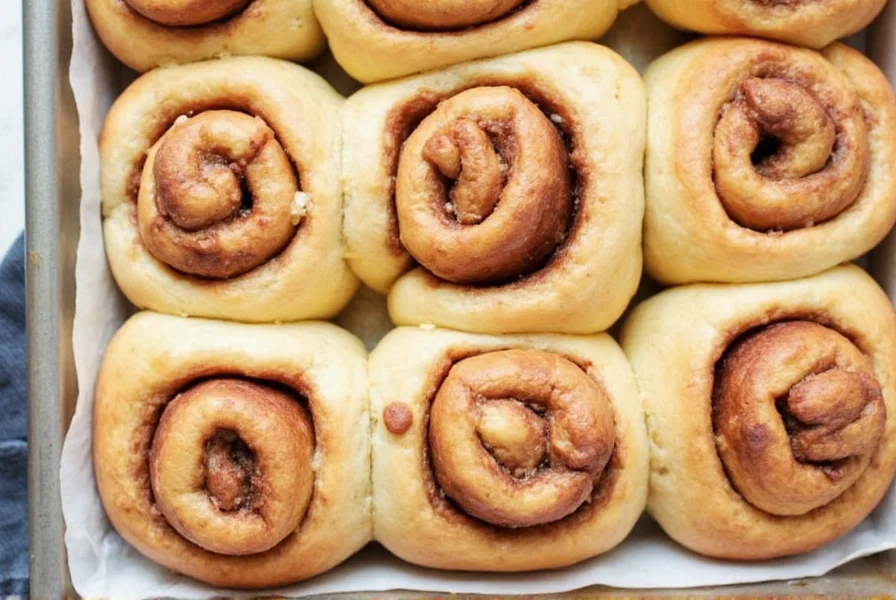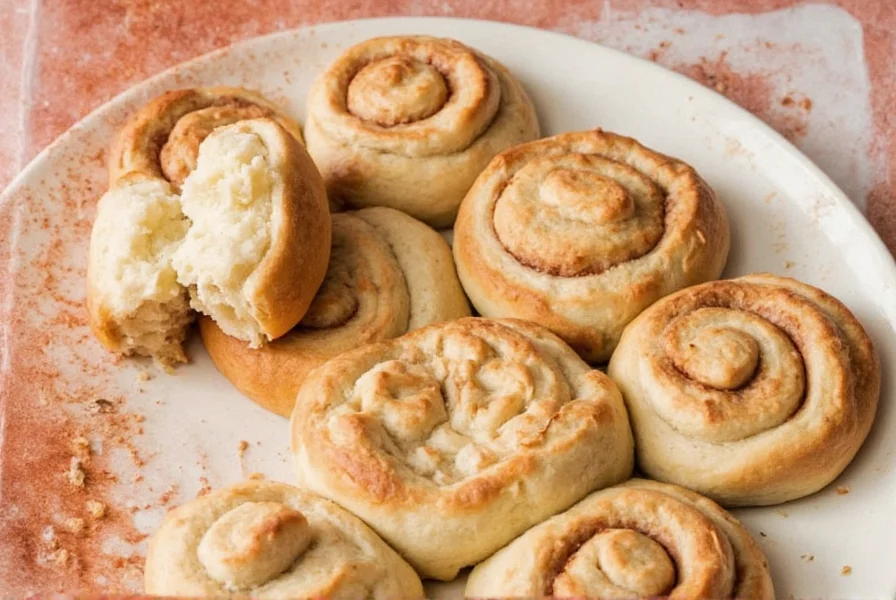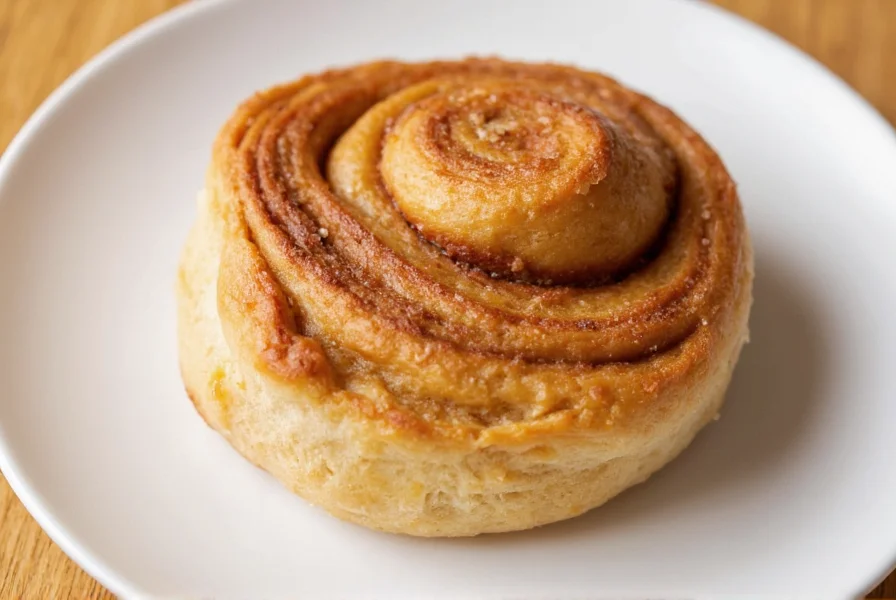Craving warm, gooey cinnamon rolls but out of yeast? You're not alone. Many home bakers search for cinnamon rolls no yeast recipes when they want to satisfy that sweet craving immediately without waiting hours for dough to rise. This guide reveals how to create bakery-quality cinnamon rolls using simple pantry staples, with no special ingredients required.
The Science Behind Yeast-Free Cinnamon Rolls
Traditional cinnamon rolls rely on yeast for that signature airy texture, but yeast-free versions use a combination of baking powder and baking soda to achieve similar results. Here's why this works:
- Baking powder provides the primary lift through a double-acting reaction (when mixed with liquids and again when heated)
- Baking soda reacts with acidic ingredients like buttermilk or yogurt to create additional lift
- Proper mixing technique develops gluten structure without overworking the dough
Unlike yeast doughs that require careful temperature control and rising time, quick yeast-free cinnamon roll recipes deliver consistent results in under an hour. The texture differs slightly—more cake-like than traditional rolls—but still achieves that perfect balance of soft interior and slightly crisp edges.
Perfect Yeast-Free Cinnamon Roll Recipe
This tested recipe produces 9 generous rolls with minimal effort. The dough comes together in one bowl, requires no kneading, and bakes up beautifully every time.
| Prep Time | Cook Time | Total Time | Servings |
|---|---|---|---|
| 20 minutes | 25 minutes | 45 minutes | 9 rolls |
Ingredients
Dough
- 2 ½ cups all-purpose flour
- 2 teaspoons baking powder
- ½ teaspoon baking soda
- ½ teaspoon salt
- ⅓ cup granulated sugar
- ½ cup unsalted butter, cold and cubed
- 1 cup buttermilk, cold
- 1 large egg
Filling
- ½ cup unsalted butter, softened
- ¾ cup packed brown sugar
- 3 tablespoons ground cinnamon
- ¼ teaspoon salt
Frosting
- 4 oz cream cheese, softened
- ¼ cup unsalted butter, softened
- 1 cup powdered sugar
- 1 teaspoon vanilla extract
- 1-2 tablespoons milk
Step-by-Step Instructions
- Prepare dry ingredients: In a large bowl, whisk together flour, baking powder, baking soda, salt, and sugar.
- Create dough base: Cut cold butter into flour mixture using a pastry cutter until pea-sized crumbs form. This step is crucial for soft yeast-free cinnamon rolls—don't skip the cold butter!
- Mix wet ingredients: In separate bowl, whisk buttermilk and egg. Pour into flour mixture and stir until just combined (do not overmix).
- Roll dough: Turn dough onto floured surface and gently pat into 12x16 inch rectangle. The dough should be slightly sticky but workable.
- Add filling: Spread softened butter evenly over dough, then sprinkle with brown sugar, cinnamon, and salt mixture.
- Roll and cut: Starting from long side, roll dough tightly into log. Cut into 9 equal pieces using dental floss for clean slices.
- Bake: Place rolls in greased 9x13 inch pan. Bake at 375°F for 22-25 minutes until golden brown and center rolls test clean with toothpick.
- Frost: While rolls cool slightly, beat frosting ingredients until smooth. Spread over warm rolls.

Troubleshooting Common Issues
Even with this easy cinnamon rolls without yeast recipe, you might encounter these common problems:
Dense or Heavy Rolls
Cause: Overmixing dough or expired leaveners
Solution: Mix dough only until ingredients are incorporated. Test baking powder by mixing ½ teaspoon with hot water—if it bubbles vigorously, it's fresh.
Dry Rolls
Cause: Overbaking or incorrect flour measurement
Solution: Use the spoon-and-level method for flour (don't scoop directly from bag). Remove rolls when center tests clean but edges are just turning golden.
Filling Leakage
Cause: Rolling too loosely or overfilling
Solution: Roll dough tightly and use recommended filling amounts. Chill cut rolls for 10 minutes before baking to set the filling.
Variations for Special Diets
This quick yeast-free cinnamon roll recipe adapts well to various dietary needs:
- Gluten-free: Substitute 1:1 gluten-free flour blend and add ½ teaspoon xanthan gum
- Vegan: Use plant-based butter, coconut milk instead of buttermilk, and flax egg (1 tbsp ground flax + 3 tbsp water)
- Lower sugar: Reduce filling sugar to ½ cup and use sugar-free cream cheese frosting

Storage and Reheating Tips
Yeast-free cinnamon rolls maintain their texture better than traditional versions when stored properly:
- Room temperature: Store in airtight container for up to 2 days
- Refrigerator: Keep for up to 5 days—reheat in microwave for 20 seconds
- Freezer: Wrap individual rolls in plastic wrap and freeze for up to 3 months. Thaw at room temperature and refresh in 300°F oven for 8 minutes
For the best texture revival, place frozen rolls in a 300°F oven for 10-12 minutes rather than microwaving, which can make them gummy. The cinnamon roll dough without yeast holds up remarkably well to freezing thanks to its cake-like structure.
Frequently Asked Questions
Can I make cinnamon rolls without yeast that are as fluffy as traditional ones?
While the texture differs slightly, you can achieve excellent fluffiness with the right technique. The key is using fresh baking powder (test it by mixing ½ teaspoon with hot water—if it bubbles vigorously, it's good), keeping ingredients cold, and not overmixing the dough. Yeast-free rolls have more of a cake-like texture rather than the chewy quality of yeast rolls, but they're equally delicious when made properly.
What's the best substitute for buttermilk in yeast-free cinnamon rolls?
Create a simple buttermilk substitute by mixing 1 cup milk with 1 tablespoon lemon juice or white vinegar. Let it sit for 5-10 minutes until slightly curdled. For richer rolls, use plain yogurt thinned with a little milk to buttermilk consistency. The acid in buttermilk reacts with baking soda for optimal rise in soft yeast-free cinnamon rolls.
Why did my yeast-free cinnamon rolls turn out dry?
Dry rolls usually result from overbaking or incorrect flour measurement. Use the spoon-and-level method for flour (scooping directly from the bag packs too much flour). Bake until the center tests clean with a toothpick but before the edges become too dark—yeast-free dough bakes faster than yeast dough. For moister rolls, increase buttermilk by 1-2 tablespoons next time.
Can I prepare yeast-free cinnamon roll dough ahead of time?
Yes! Prepare the cut rolls and place them in the baking pan, then cover tightly and refrigerate overnight. When ready to bake, let them sit at room temperature for 20 minutes while the oven preheats. The cold dough will rise slightly in the oven. This quick yeast-free cinnamon roll recipe actually benefits from this method as the flavors develop overnight.











 浙公网安备
33010002000092号
浙公网安备
33010002000092号 浙B2-20120091-4
浙B2-20120091-4